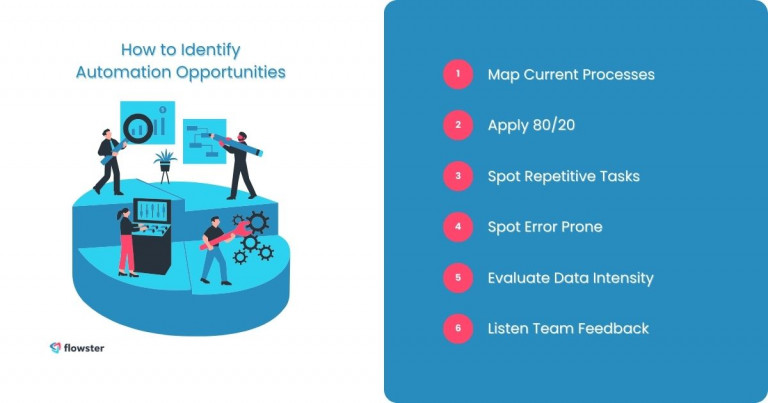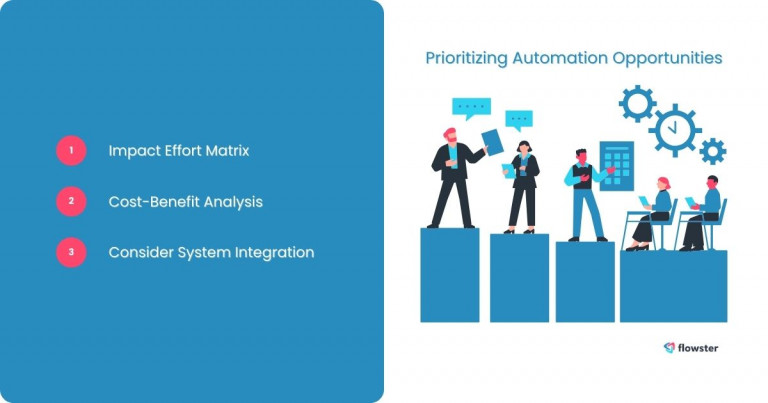Is Your Business Drowning in Tedious Tasks? Learn How to Identify Processes to Automate!
Imagine this: Your team is spending hours on data entry, slogging through paperwork, and constantly chasing down approvals. Sound familiar? You’re not alone. Many businesses struggle with inefficient, manual processes that drain time and resources.
Business process automation (BPA) has the potential to significantly transform business operations. But figuring out which processes to automate in business is the real challenge.
This article will guide you through a simple, step-by-step approach. You’ll learn how to pinpoint and prioritize processes ripe for automation. The result? Increased efficiency, reduced costs, and happier employees. Let’s dive in and unlock the benefits of workflow automation for your business.
Article Outline
Laying the Groundwork: What Makes a Process Ripe for Automation?
Before you start automating everything in sight, it’s crucial to understand what makes a process a good candidate. Not all tasks are equal! Knowing the key characteristics will help you focus your efforts and maximize your return on investment. Successfully identifying processes to automate in business starts with understanding the fundamentals.
A. Defining an Automatable Process
Automatable processes share some common traits. They’re typically repetitive, rule-based, and often involve a high volume of tasks. Think of things like data entry, invoice processing, or generating standard reports. These processes also tend to be digital, occurring within a static system, and are easy to break down into instructions. Automation isn’t about replacing humans but freeing them from mundane tasks. By automating these tasks, you allow your workforce to focus on core, value-adding functions.
B. Common Misconceptions About Automation
There are many workflow automation myths out there. One is the idea that automation is too expensive or complex. Another misconception is that it’s only for large companies. Modern automation tools are increasingly scalable and accessible. Low-code platforms, for instance, allow users to create and customize automated processes with minimal coding. Don’t let these myths hold you back from exploring workflow automation for beginners and its potential to transform your business.
Want to learn more about workflow automation? Check out this article: “Traditional Workflow Automation vs. AI.”
Flowster's AI-Driven Automation
A Practical Guide: How to Uncover Hidden Processes to Automate in Business
Ready to roll up your sleeves? Identifying processes to automate in business doesn’t have to be a shot in the dark. This step-by-step guide will guide you through a proven method for identifying automation opportunities within your organization. By systematically analyzing your workflows, you can uncover hidden potential for efficiency gains and cost savings.
A. Process Mapping & Documentation
The first step is to thoroughly analyze your current workflow. This involves documenting all the processes and tasks that are part of your daily operations. By creating a comprehensive workflow map, you’ll gain a clear understanding of your existing processes, which is crucial for pinpointing areas where automation can make a difference.
- Visualize Your Workflows: Process mapping helps you visualize and understand the steps involved in each process. Use flowcharts or Business Process Model and Notation (BPMN) to illustrate the flow of activities, decision points, and data exchanges.
- Involve Your Team: Be sure to involve relevant team members in this analysis to get a well-rounded perspective.
- Document Everything: Document each step, decision point, and data input/output. Identify who is responsible for each task, how each task is currently performed, and what the inputs and outputs are for each task.
B. The “80/20 Rule” (Pareto Principle) for Process Analysis
The 80/20 rule suggests that 20% of your processes cause 80% of your problems. Focus on the 20% of processes that cause 80% of the problems (e.g., delays, bottlenecks, errors). Identify high-impact areas for automation.
- Pinpoint Key Bottlenecks: Identify the processes that contribute most significantly to delays, errors, or inefficiencies.
- Prioritize High-Impact Areas: Focus your automation efforts on the areas that will yield the greatest return on investment.
- Strategic Decision-Making: Opportunity analysis helps you make informed decisions about where to invest in industrial automation, ensuring that your efforts align with your long-term objectives and create a clear roadmap for the future of manufacturing automation in your company.
C. Identifying Repetitive and Time-Consuming Tasks
Look for tasks performed frequently and requiring significant manual effort. These are prime candidates for automation.
- Spot the Mundane: These are often hidden within larger processes.
- Examples: Data entry, invoice processing, report generation, customer onboarding, task scheduling, and data integration.
- Free Up Valuable Time and Resources: Automation not only reduces manual tasks but also improves accuracy and frees up valuable time and resources for more strategic activities.
D. Spotting Error-Prone Processes
Processes where human error leads to significant costs or customer dissatisfaction are ideal for automation.
- Minimize Mistakes: Automation can significantly reduce the risk of human error.
- Examples: Order fulfillment, inventory management, compliance reporting.
- Improved Accuracy: Automation not only reduces manual tasks but also improves accuracy and frees up valuable time and resources for more strategic activities.
E. Evaluating Data-Intensive Processes
Processes that involve collecting, processing, and analyzing large amounts of data can greatly benefit from automation.
- Data Collection, Transformation, and Usage: Begin by defining all the processes that your firm uses. Even if it works, automation can save time and make it better.
- Examples: Marketing analytics, customer relationship management (CRM), financial reporting.
- Where there is data, there is an opportunity for automation: As the process happens, ask yourself if you can innovate the process to make it more practical. Are there any steps that can be removed? Ask all who are involved if there are pain points or aspects that they wish would be different.
F. Employee Feedback: The Inside Scoop
Encourage input from employees who perform the processes daily. They often have valuable insights into bottlenecks and inefficiencies.
- Talk to Your Team: Your team is the best source of information for this.
- Bottom-Up Approach: Encouraging business teams to internally identify automation opportunities relies on education and leadership support.
- Overcome Resistance to Change: Realizing the big benefits of going digital for both businesses and people can help you get past this resistance and fully embrace automating boring tasks.
Want to learn more about process mapping? Check out this article: “How Process Mapping Can Help Identify Bottlenecks.”

Making the Cut: How to Prioritize Processes to Automate in Business
So, you’ve identified a bunch of potential processes to automate in business. Great! But where do you start? Not all automation projects are created equal. Prioritization is key to maximizing your ROI and ensuring your automation efforts align with your business goals. A strategic approach will help you focus on the projects that deliver the most value with the least amount of effort.
A. Impact vs. Effort Matrix
This matrix is a simple but powerful tool for evaluating potential automation projects. It helps you visualize the potential impact of each project against the effort required to implement it. Focus on “quick wins”—high-impact, low-effort projects. These provide a good return with the highest probability of success.
- Plot Your Projects: Create a 2×2 matrix with “Impact” on one axis and “Effort” on the other. Plot each potential automation project on the matrix based on your assessment of its potential impact and the effort required to implement it.
- Focus on Quick Wins: Prioritize projects that fall into the “high impact, low effort” quadrant. These are your quick wins—projects that can deliver significant benefits with minimal investment.
- Consider High Impact, High Effort: These projects may be worth pursuing but require more careful planning and resource allocation.
B. Cost-Benefit Analysis
Quantify the potential benefits of automation (e.g., reduced labor costs, increased efficiency, fewer errors) and compare them to the costs of implementation. This helps you determine the return on investment (ROI) for each project.
- Quantify the Benefits: Estimate the potential cost savings, revenue increases, and other benefits that automation can deliver.
- Calculate the Costs: Include the costs of software, hardware, implementation, training, and ongoing maintenance.
- Compare and Prioritize: Compare the costs and benefits for each project and prioritize those with the highest ROI.
C. Consider Integration
Prioritize processes that can be easily integrated with existing systems. Seamless integration maximizes the benefits of workflow automation and ensures that your automation efforts don’t create new problems.
- Assess Integration Complexity: Evaluate how easily each process can be integrated with your existing systems.
- Look for Compatibility: Prioritize processes that use structured data formats and can be integrated with other applications.
- Streamline Data Flow: Choose automation projects that improve data flow and reduce data silos.
Want to learn more about process improvement? Check out this article: “Process Improvement Challenges: Conquer Them Like a Pro!”

Real-World Applications: Examples of Processes to Automate in Business
Now that you understand how to identify and prioritize automation opportunities, let’s look at some concrete examples. These are just a few of the many processes to automate in business to improve efficiency and reduce costs. By exploring these examples, you can get inspired and start thinking about how automation can transform your own organization. Remember, the goal is to streamline operations, reduce errors, and free up valuable time for your team to focus on strategic initiatives.
A. Marketing Automation
Marketing automation can streamline your marketing efforts and improve lead generation. Automate repetitive tasks to nurture leads, personalize customer interactions, and measure campaign effectiveness.
- Email Marketing Campaigns: Automate email sequences, personalize messages, and track engagement metrics.
- Social Media Scheduling: Schedule posts in advance and manage your social media presence more efficiently.
- Lead Nurturing: Automate the process of guiding leads through the sales funnel with targeted content and personalized interactions. You can find inspiration from various sales funnel examples to better understand how successful businesses structure their lead nurturing strategies.
B. Sales Automation
Sales automation can help your sales team close more deals and improve customer relationships. Automate tasks such as data entry, follow-ups, and quote generation to free up your sales team to focus on building relationships and closing deals.
- CRM Data Entry: Automatically update CRM records with new customer information.
- Sales Follow-Ups: Automate follow-up emails and reminders to ensure leads don’t fall through the cracks.
- Quote Generation: Streamline the process of creating and delivering quotes to potential customers.
C. Customer Service Automation
Customer service automation can improve customer satisfaction and reduce support costs. Automate tasks such as answering frequently asked questions, routing tickets, and providing self-service options.
- Chatbots: Use chatbots to answer common questions and provide instant support.
- Knowledge Base Management: Create a self-service knowledge base that customers can use to find answers to their questions.
- Ticket Routing: Automatically route support tickets to the appropriate agent based on topic and priority.
D. Finance and Accounting Automation
Finance and accounting automation can reduce errors and improve efficiency in your financial operations. Automate tasks such as invoice processing, expense reporting, and reconciliation.
- Invoice Processing: Automate the process of capturing, processing, and paying invoices.
- Expense Reporting: Streamline the process of submitting and approving expense reports.
- Reconciliation: Automate the process of matching transactions and identifying discrepancies.
E. HR Automation
HR automation can streamline your HR processes and improve employee satisfaction. Automate tasks such as onboarding, payroll, and benefits administration.
- Onboarding: Automate the process of welcoming new employees and providing them with the information they need to get started.
- Payroll: Automate the process of calculating and distributing paychecks.
- Benefits Administration: Streamline the process of enrolling employees in benefits programs.
Want to learn more about workflow automation software? Check out this article: “Don’t Get Lost in the Options: Choose the Right Workflow Automation Software (FAST!)”
Capture Your Processes in Minutes!
Taking the Next Step: Streamlining Processes to Automate in Business
Identifying processes to automate in business is the first step toward a more efficient, productive, and profitable future. By understanding what makes a process automatable, systematically analyzing your workflows, and prioritizing your efforts, you can unlock the full potential of automation. From marketing and sales to customer service and finance, the opportunities are endless. Automation isn’t just about saving time and money; it’s about empowering your team to focus on what matters most: innovation, creativity, and strategic growth.
Are you prepared to embark on this journey? Don’t let the idea of workflow automation for beginners intimidate you. Start small, focus on quick wins, and gradually expand your automation efforts as you gain confidence and experience.
Ready to get started? Explore our free templates at Flowster Marketplace.




